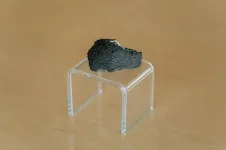(Press-News.org) Wastewater injection resulting from oil and gas production in Oklahoma caused a dramatic rise in seismic activity in the state between 2009 and 2015. But regulatory efforts to backfill some injection wells with cement and reduce injection volumes have been effective in lowering the state’s induced earthquake rate, according to a new study in The Seismic Record.
The study by Robert Skoumal of the U.S. Geological Survey and colleagues lends further support to the idea that reducing the depth of wastewater injection can decrease seismic activity—a finding that could have implications for controlling the rise of induced seismicity in west Texas and eastern New Mexico.
“Each basin is different, but we've repeatedly seen the connection between injection depth and the likelihood of inducing earthquakes across the country,” Skoumal said.
In 2015, the Oklahoma Corporation Commission (OCC) mandated that wells injecting water into the lower portion of a sedimentary formation called the Arbuckle Group—which lays on top of the region’s basement rock—must be backfilled with cement to limit injection to shallower levels.
If these “plug-backs” had been applied to only half of the volume injected into the lower Arbuckle, the 2024 seismicity rate in Oklahoma would be about 2.5 times larger than it is under the current plug back scenario, the researchers concluded.
If no plug backs were in place, the seismicity rate would be about 4.4 times larger.
“It's the first time we've had the opportunity to look at the influence that reducing injecting depths has on induced earthquakes across such a large, regional scale,” said Skoumal.
“The science said proximity to the basement matters, and the OCC reduced the proximity of those wells,” he added. “This study is confirmation that those plug back efforts successfully reduced the earthquake rates.”
Hydrocarbon production in Oklahoma is connected to a rise in earthquake rates starting around 2009 and peaking in 2015, when there were 888 magnitude 3 or larger earthquakes in the state. There have been five earthquakes of magnitude 5 or larger, including the 2011 Prague and the 2016 Pawnee earthquakes that caused notable damage.
Numerous studies, including some by the TSR authors, demonstrate that this rise in seismicity was primarily related to wastewater disposal into the Arbuckle in central Oklahoma. From an industry perspective, the formation was ideal for disposal, Skoumal said.
“It has a very high permeability, meaning fluids will rapidly flow away from the well, making room for more fluid. It is underpressured, meaning water can be ‘poured’ down a well without using pumps, and it's easily accessible across the region,” he noted. “For every gallon of oil they were bringing up, 10 gallons of water came up with it. There was a tremendous volume of fluid that had to go somewhere, and the Arbuckle was an economical place to dispose of it.”
Earthquake rates have declined in the state since their 2015 peak, in part due to economic factors that led to less oil production in the area, and therefore less wastewater injection. To discover whether the plug backs and volume reductions led to less induced seismicity, Skoumal and his colleagues created several earthquake models that use data on plug backs, total wastewater injection volumes and the observed earthquake rates.
They found that a model that considered only wastewater volumes injected into the lower Arbuckle, and had plug backs fully effective at reducing earthquake rates, provided the best explanation for patterns in the observed seismicity rates.
While induced seismicity rates have fallen in Oklahoma, they are on the rise in the Permian Basin of western Texas and southeastern New Mexico which has experienced six magnitude 5 and larger earthquakes since 2020. “We find the combination of reducing volumes and plugging back wells were effective in Oklahoma, and it could be an effective strategy elsewhere,” Skoumal said.
END
Plugged wells and reduced injection lower induced earthquake rates in Oklahoma
2024-11-14
ELSE PRESS RELEASES FROM THIS DATE:
Yin selected as a 2024 American Society of Agronomy Fellow
2024-11-14
Frank Yin, agronomy researcher in the University of Tennessee Department of Plant Sciences, has been selected as a 2024 American Society of Agronomy (ASA) Fellow.
The honor was awarded as a result of Yin’s more than 35 years of research contributions to institutions across the world, including 16 years at the University of Tennessee Institute of Agriculture (UTIA). Yin was recognized for the Fellowship at the national meeting of ASA in San Antonio, Texas in November.
“I am humbled and honored to receive this distinction, but above all I am ...
Long Covid could cost the economy billions every year
2024-11-14
Working days lost to long Covid could be costing the economy billions of pounds every year as patients struggle to cope with symptoms and return to work, finds a new study led by UCL researchers.
The research, published in BMJ Open and funded by the National Institute for Health and Care Research (NIHR), examined the impact of long Covid on 4,087 patients who were referred to a long Covid clinic and registered in the Living With Covid Recovery (LWCR) programme between August 2020 and August 2022.
As part of their NHS treatment for the condition, the patients ...
Bluetooth technology unlocks urban animal secrets
2024-11-13
Mobile phones could be the key to a cheaper and more reliable way of tracking animals for ecology and conservation research, according to a new study from The Australian National University (ANU).
Traditional animal tracking methods are often expensive and require the tagged animals to be close to the tracking technology.
Now, ANU researchers have developed a cheap, lightweight Bluetooth beacon that can provide regular updates through our network of mobile phones in areas used by people carrying phones or smartwatches.
Study lead author and ANU ecologist, ...
This nifty AI tool helps neurosurgeons find sneaky cancer cells
2024-11-13
FOR IMMEDIATE RELEASE
Media Contact: Suzanne.Leigh@ucsf.edu, (415) 680-5133
Subscribe to UCSF News
This Nifty AI Tool Helps Neurosurgeons Find Sneaky Cancer Cells
Technique offers new hope for increased survival in patients with brain tumors.
What’s New:
An AI-based diagnostic system reveals cancerous tissue that may not otherwise be visible during brain tumor surgery. This enables neurosurgeons to remove it while the patient is still under anesthesia – or treat it afterwards with targeted therapies.
Why it Matters:
Brain tumors can ...
Treatment advances, predictive biomarkers stand to improve bladder cancer care
2024-11-13
CHAPEL HILL, North Carolina — Recent advances in bladder cancer treatments may offer hope of curative care to more patients, including those with high-risk localized, muscle-invasive disease, according to an editorial published in the New England Journal of Medicine.
Matthew Milowsky, MD, FASCO, a bladder cancer expert at UNC School of Medicine and UNC Lineberger Comprehensive Cancer Center, wrote that the promise of incorporating new treatments and predictive biomarkers to select the right patient for the right treatment every time offers a bright future for bladder cancer patients.
Platinum-based chemotherapy has long been the standard treatment for metastatic bladder cancer and for ...
NYC's ride-hailing fee failed to ease Manhattan traffic, new NYU Tandon study reveals
2024-11-13
New York City's 2019 ride-hailing surcharge cut overall taxi and ride-share trips by 11 percent in Manhattan but failed to reduce traffic congestion, a key goal of the policy, according to a new NYU Tandon School of Engineering study published in Transportation Research Part A.
“While this surcharge differs from the MTA's proposed congestion pricing plan, the study's findings can contribute to the current discourse,” said Daniel Vignon – assistant professor of Civil and Urban Engineering (CUE) and member of C2SMARTER, a U.S. Department of Transportation Tier 1 University Transportation Center – who led the research with CUE PhD student Yanchao ...
Meteorite contains evidence of liquid water on Mars 742 million years ago
2024-11-13
An asteroid struck Mars 11 million years ago and sent pieces of the red planet hurtling through space. One of these chunks of Mars eventually crashed into the Earth somewhere near Purdue and is one of the few meteorites that can be traced directly to Mars. This meteorite was rediscovered in a drawer at Purdue University in 1931 and therefore named the Lafayette Meteorite.
During early investigations of the Lafayette Meteorite, scientists discovered that it had interacted with liquid water while on Mars. Scientists have long wondered when that interaction with liquid water took place. ...
Self-reported screening helped reduce distressing symptoms for pediatric patients with cancer
2024-11-13
TORONTO – Regular, self-reported symptom screening was associated with reduced symptom burden when compared with usual care for pediatric patients with cancer, according to new research led by scientists at the University of Toronto and The Hospital for Sick Children (SickKids).
The study, published today in JAMA, reported results of a randomized control trial of 445 participants aged 8 to 18 years receiving cancer treatment from across 20 pediatric cancer centres in the U.S. Half of the centres participating implemented the screening intervention while ...
Which risk factors are linked to having a severe stroke?
2024-11-13
EMBARGOED FOR RELEASE UNTIL 4 P.M. ET, WEDNESDAY, NOVEMBER 13, 2024
MINNEAPOLIS – People with conditions or habits such as high blood pressure, an irregular heartbeat called atrial fibrillation, or smoking, not only have a higher risk of stroke, they may also have more severe strokes than people without these risk factors, according to a study published in the November 13, 2024, online issue of Neurology®, the medical journal of the American Academy of Neurology.
“Stroke can lead to disability or even death, yet there are a number of risk factors that people can modify with a change ...
Opening borders for workers: Abe’s profound influence on Japan’s immigration regime
2024-11-13
Japan grapples with labor shortage due to low birth rates and an aging population, prompting recent governments to bring in more foreign workers. Under the leadership of the late Prime Minister Shinzo Abe, significant immigration reforms were introduced between 2012 and 2020, aiming to alleviate these challenges by increasing the foreign population. However, despite these efforts, the government has continued to uphold the long-standing status quo of not having a formal immigration policy, mainly to balance business and nationalist interests.
This status ...




